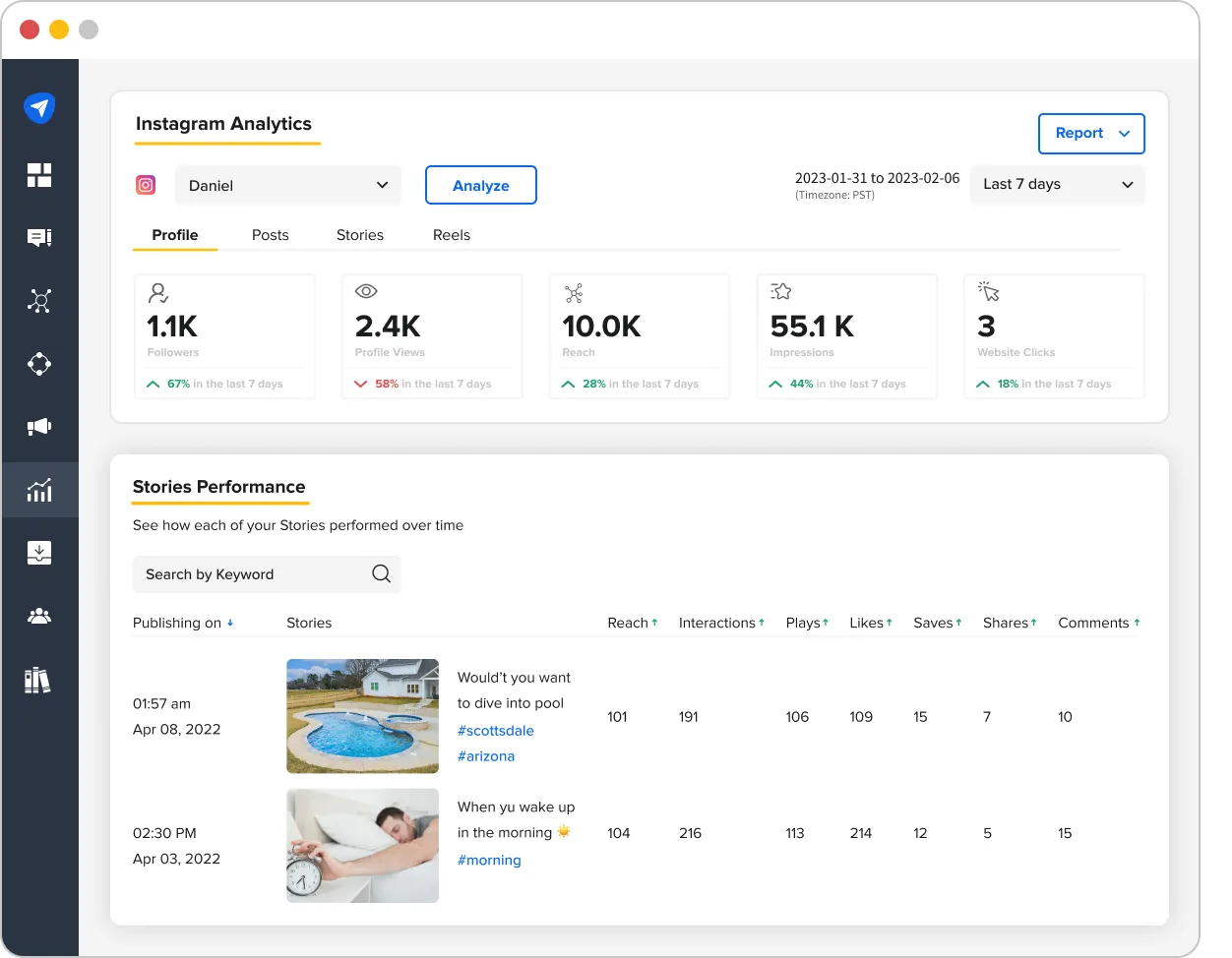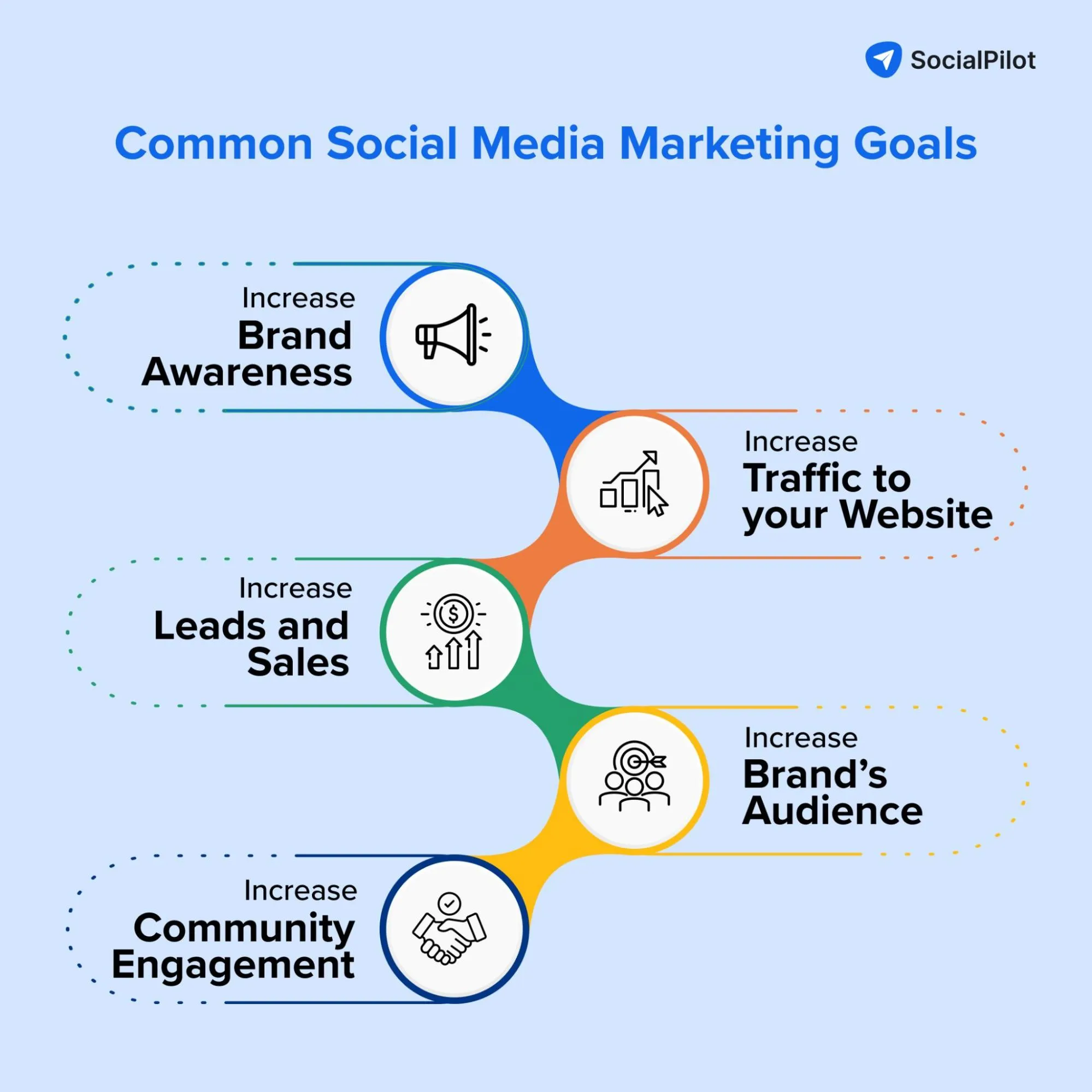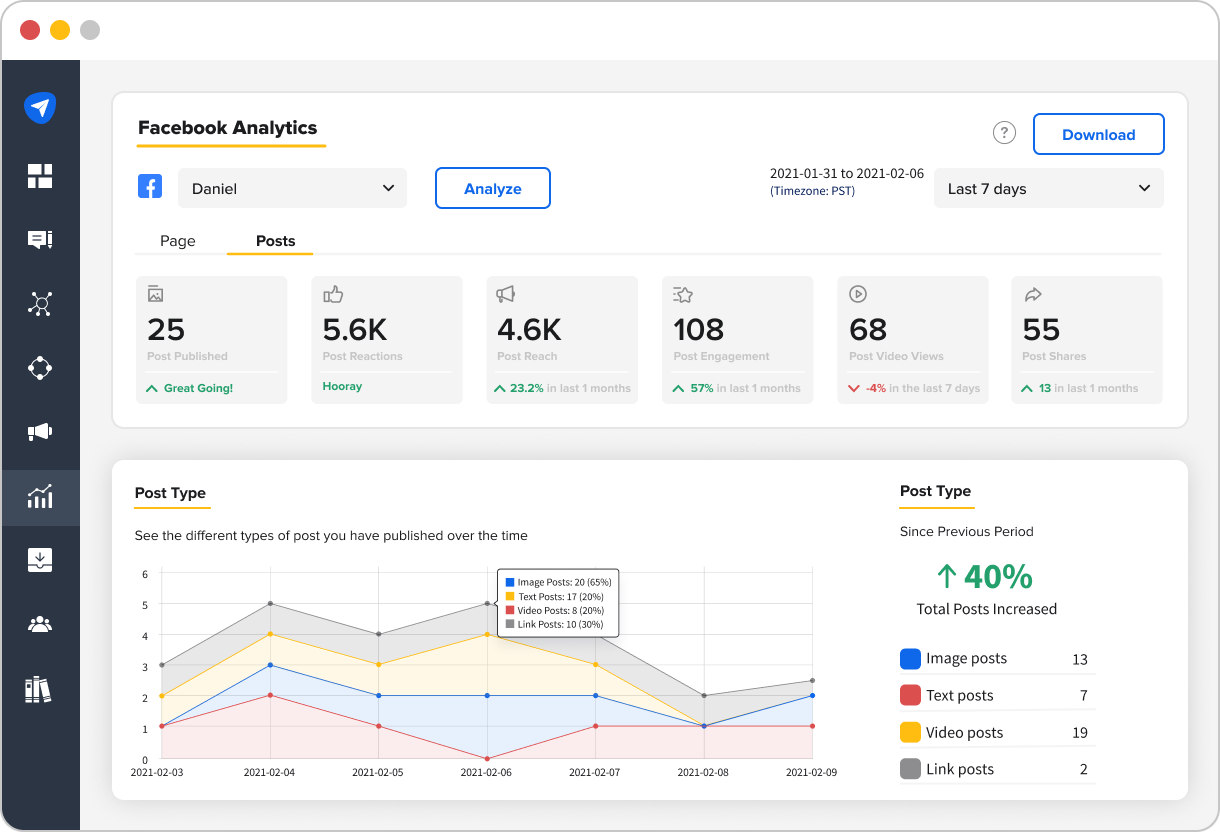A Guide To Social Media Analytics: Measure Social Social Success
Have you ever scrolled through your social media feed and wondered, “Is any of this actually working?” Yeah, […] The post A Guide To Social Media Analytics: Measure Social Social Success appeared first on SocialPilot.

Have you ever scrolled through your social media feed and wondered, “Is any of this actually working?”
Yeah, us, too.
In this age of content overload, creating and posting great stuff is no longer enough. You need to understand what resonates with your target audience and why. That is where the practice of social media analytics comes in.
By analyzing the data collected behind your social media presence, you can unlock powerful and actionable insights to fine-tune your social media strategies and get real results.
This goes beyond vanity metrics such as likes, followers, and impressions and helps you understand the why behind these numbers.
By breaking down the data gathered from social media channels, you can learn what makes people tick, prove the ROI of your social media efforts, and tailor your marketing campaigns accordingly.
In this guide, we will walk you through the complete process of doing social media analysis, the types of analytics you need to consider, and the right tools to measure these metrics.
So, without any further ado, let’s get started!
What is Social Media Analytics?
Social media analytics is the process of collecting, analyzing, and interpreting data from various social media platforms to understand how your audience perceives and interacts with your content. This involves tracking and evaluating metrics such as likes, shares, comments, and mentions to understand how each content piece is performing on a macro level and how your audience responds to it.
What all gets covered in social media analytics, you ask?
The main areas include performance metrics, audience demographics, competitor insights, paid social media performance, and brand sentiment. Deciphering all this data helps marketers and businesses understand how their social media campaigns perform and impact their business goals.
This leads us to an important question:
Why is Social Media Analytics Important?
Let’s be real; as social media marketers, we all crave that “aha!” moment—the one where we crack the code and our content goes viral like wildfire. But when the competition on social is so high, flying blindly just doesn’t cut it.
Tracking social media analytics is essential for all savvy marketers, and here’s why:
- Deciphering Audience Sentiments: Analyzing interactions, from comments to mentions, helps discern whether content resonates with your audience or needs adjustments. It offers a clear picture of the emotions behind every interaction.
- Strategic Content Creation: The insights collected can help you pinpoint which type of interactive content, videos, blogs, or infographics garners the most attention. This data-driven approach ensures that content strategies are tailored for maximum engagement.
- Competitor Analysis: A top-down social media analysis can reveal who you’re competing with, identify market opportunities, and use it to hone your own strategies.
- Support Effectiveness: The analysis can help you determine the effectiveness of your online customer service, from response times to the success of your chatbot interactions.
- Setting Social Media Goals: Finally, the most crucial one is your social media goals. If you’re not hitting your goals, it’s time to update your social media strategy. Basically, social media analysis gives you a holistic view of what part of your strategy is working in your favor and what needs to be changed.
These benefits cannot be neglected, and the list goes on and on. The bottom line is that you need to get started with the social analysis first and be rational while doing it.
But what all gets covered in social media analytics?
Let’s have a look at the different analytics covered in the audit. Shall we?
What are the Types of Social Media Analytics?
Well, there are several social media metrics, but we have defined them into 6 major categories that offer a granular look at what data you can look at. Here are these:
Performance Metrics
This is your bread and butter, providing a birds-eye view of how your social media content is performing. Also known as descriptive metrics, it includes essential metrics such as:
- Reach
- Impressions
- Engagement
- Comments
- Shares
- Views
- Website clicks
It essentially answers the question: “What happened?”
You can easily view all these metrics inside the SocialPilot dashboard:

You can get detailed insights into different types of posts. Quickly identify the most viewed content.
Audience Analytics
The next metric you examine in your analysis is audience analytics. This goes beyond just numbers to understand who your followers are, including demographics like age, gender, location, and interests.
By analyzing demographics, interests, and online behavior, you can tailor your content to your audience’s preferences and behaviors, ensuring that your content strategy reaches the right target audience.

Branding Analysis
Also known as brand sentiment, this key metric dives into conversations and mentions about your brand to help you understand how people perceive it on the internet. This allows you to track areas for improvement, detect negative sentiment to avoid any PR crisis before it happens, and build a strong brand reputation.
Competitor Analytics
Keeping an eye on the competition and what they are doing is crucial for any business strategy. Competitor analysis breaks down what kind of content your competitors are posting, their target audience demographics, what is working for them, and how their overall social media strategy and performance stacks against you.
It exposes their share of voice, helps you establish benchmarks, and finds potential gaps in their strategies that you can exploit to stay ahead of them.
Paid Social Media Analytics
If you invest in paid social media advertising on social media platforms, this is one critical area you should not overlook. Here, you can track the performance of your paid campaigns and measure metrics such as:
- Cost Per Click (CPC)
- Click-Through Rate (CTR)
- Cost Per Acquisition (CPA)
- Total Ad Spend
- Return on Investment (ROI)
- Return on Ad Spend (ROAS)
The goal is to increase the efficiency of ad spending and optimize the targeting for better results.
Influencer Analytics
This type of analytics helps you assess the effectiveness of your influencer marketing campaigns. You can track the reach and engagement generated by influencer posts, measure the ROI and conversion rates, and identify the most impactful influencers for your brand.
Now that you finally know what the types of social media analytics are, it is time to learn how to track them.
How To Track Social Media Analytics
Tracking social media analytics does not need to be a tedious and rigorous process. It’s simple: You need data to start and a clear roadmap for where to begin. Fantastic!
We have broken down the entire process into 5 simple steps. Read on to get started with the process:
Step 1: Set SMART Goals
Any social media strategy starts with a proper plan of action. You create a marketing strategy based on your business goals, but it is not possible without a map of your goals and how you will track them.
The first step starts with defining SMART goals. SMART is an acronym that stands for Specific, Measurable, Achievable, Relevant, and Time-bound. This framework helps you clarify your goals deeper and increase your chances of success.
Let’s take an example to understand this:
- Specific: Be specific with your goals; what do you want to achieve? Instead of saying, “Increase website traffic from Instagram,” you can say, “Increase website traffic from Instagram by 25% within the next 3 months.”
- Measurable: Set indicators such as quantifiable numbers that you will use to measure whether you’re getting closer to your goals or not.
- Achievable: Setting unrealistic expectations can affect your overall performance and eventually slow you down. Analyze your past performance and, based on it, set achievable targets.
- Relevant: Your social media goals should be relevant and align with your broader business goals.
- Time-bound: Your goals should have a deadline attached. Deadlines help create a sense of urgency and drive teams and individuals to allocate and complete tasks efficiently.
For your reference, here are some common goals that businesses use:

Furthermore, after setting up your goals, you need to identify what metrics you need to measure.
Step 2: Identify Your Key Metrics
When we talk about social media, there are a lot of metrics and numbers flying out there that might distract you from the broader picture. You need to establish benchmarks and decide which social media metrics to use.
These metrics can vary from platform to platform, but here are some key metrics you should always consider:
- Brand Awareness: Reach, impressions, follower growth, brand mentions.
- Engagement: Likes, comments, shares, re-shares, click-through rates (CTRs).
- Website Traffic: Website clicks, referral traffic.
- Lead Generation: Lead form submissions and sign-ups.
- Sales: Conversions, revenue generated through social media
Step 3: Use the Right Tools
Most social media platforms offer built-in analytics for tracking the performance of your social media profiles. However, for deeper insights, you must have social media analytics tools like SocialPilot in your arsenal.
Here are some of the questions you can ask before opting for any tool:
- What are my social media goals?
- Which social media platforms do I need to track? (Is it Facebook, Instagram, LinkedIn, Pinterest, or Twitter)?
- Does the tool integrate with the social media platforms that I use?
- Which metrics and reports does the tool offer?
- Does the tool provide customizable dashboards and reports?
- Do I want to track paid social media campaigns?
- And, what is the pricing structure of the tool?
When you ask these questions to yourself, your team, or your clients, you will basically get a clear picture of which tool you should use.
Step 4: Track, Analyze, and Adapt
The magic happens in this stage! Regularly monitor your selected metrics and analyze them in relation to your SMART goals. Here are some methodologies you can consider:
- Look for Trends: Identify patterns in your social media data over time. Are there any specific content types that consistently generate higher engagement? Are there any posting times that outperform others?
- Benchmarking: Compare your performance against industry averages or your competitors. This can help you identify areas for improvement.
- A/B Testing: Try different approaches to see what resonates best with your audience. For example, try variations in content format, posting times, or even ad copy.
Stay regular with this step to uncover crucial performance metrics.
Step 5: Start Making Adjustments To Your Strategy
Voila, you are officially done with the data collection and analysis, but what now?
It’s time to apply changes in your strategy and start driving growth. Based on your analysis, adapt your social media strategy to maximize results.
Here are some actions you should start taking:
- Double Down on Winning Content: If a particular type of content consistently performs well, start creating more of it!
- Optimize Posting Schedule: Schedule your posts for the best times when your audience is most active.
- Refine Your Targeting: Tailor your content and brand messaging to specific audience segments based on demographics and their interests.
- Experiment with Paid Social: If you want to reach a wider audience, Consider investing in paid advertising and achieve specific goals.
- Refine Your Influencer Strategy: If you run influencer marketing campaigns, partner with influencers who resonate with your target audience and deliver measurable results.
Remember, social media analytics is an ongoing process. By consistently tracking, analyzing, and adapting your strategy based on the audit, you can transform your social media presence into a powerful tool and start achieving your marketing goals.
5 Best Social Media Analytics Tools to Use
Social media analytics tools are the compass that guides brands to success. They provide invaluable insights, shape strategies, and drive engagement. If you are unsure which tools to use, here are some of the top ones you must try:
1. SocialPilot
SocialPilot stands out as a comprehensive solution for social media analytics. It offers a plethora of features that make tracking and managing your brand’s image a breeze:
- Content Performance Analysis: Effortlessly track the performance of your content across Instagram, Facebook, Twitter, LinkedIn, and Google My Business. Fine-tune your content strategy by identifying which posts garner the most visibility and engagement, focusing on what truly resonates with your audience.
- Audience Insights: Dive deep into audience demographic metrics such as age, gender, location, and more to understand trends and growth patterns.
- Optimal Posting Times: Timing is everything in social media. SocialPilot’s analytics identify the best times to post, ensuring content reaches the audience when they’re most active. By analyzing activity patterns, brands can maximize their content’s visibility and engagement potential.
- Advanced Reporting: You can generate and combine analytics reports of multiple profiles and networks and auto-schedule them.

2. Meltwater
Meltwater is a global company specializing in media intelligence and social listening. They provide software solutions and services to help businesses monitor their online presence, track media coverage, and gain insights from social media and other online sources.
Meltwater collects data from various online channels, including social media platforms, news websites, blogs, and forums. Their social media analytics capabilities allow businesses to understand their brand’s reputation and industry trends.
3. Hootsuite
Hootsuite is a social media calendar and planner with analytics capabilities. You can measure and analyze performance across different social media platforms in one streamlined place. Reports inform the best times to post based on when your audience is the most active and identify top-performing posts. Pre-built templates make reports customizable and easy to digest.
4. Grow
Grow users can gain full visibility into engagement on all their social accounts. The tool integrates with HubSpot, Salesforce, Google Ads, Facebook, Marketo, and Microsoft Office to view all data in one place.
Grow breaks down complex data into graphs and visuals, and your social reports are easily sharable, which is helpful if multiple people are working on the same project. Grow’s reports are built with metrics chosen by the user, meaning you can customize them to suit your needs.
5. Brandwatch
Brandwatch is a consumer intelligence tool and social media management solution with analytics capabilities. Social insights like social listening and competitor benchmarking can inform your content creation. Audience profile cards can help you better understand the audiences engaging with your social content, and customizable dashboards allow you to view key data in one place.
Start Measuring Your Social Media Analytics
In short, mastering social media analytics empowers you to transform data into strategic insights for tangible results. Start by setting clear marketing goals, opting for the right tools, and analyzing your data regularly.
Take action today—utilize these insights to refine your strategy and elevate your social media presence. Every interaction on your platform is an opportunity; make sure you’re making the most of it.
The post A Guide To Social Media Analytics: Measure Social Social Success appeared first on SocialPilot.
What's Your Reaction?




























